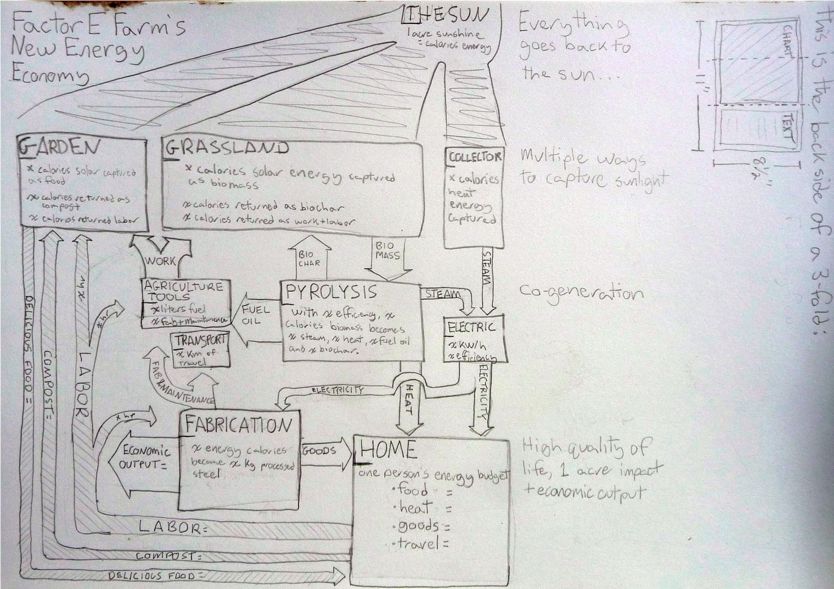Factor e Farm Energy Cycle
Introduction
We need to start by defining our terms. We use:
- 1 calorie = 4.2 Joules
- This is the amount of heat energy needed to raise the temperature of one gram of water by 1 degree Celsius
- 1 Calorie = 4200 J
- calorie with capital C is the heat energy needed to raise the temperature of one kilogram of water by 1 degree Celsius
- calory = 4.2 Joules
- This is used for food energy values.
Furthermore:
- One kilowatt hour (1 kWhr) is 3,600,000 joules or 3.6 megajoules; look up Joule on wikipedia; this is also equivalent to 1 Whr = 3.6 kilojoules = 15 kilocalories = 15 kcal
- Solar energy coming to the earth is about 1 kW per square meter
- 1 acre is about 4000 square meters
- Thus, 1 acre intercepts a power of 4 megawatts
- Given a single day has 6 hours of direct sunlight on average over the year, we have a total of approximately 24 megawatt hours per day coming to each acre of Factor e Farm, or a total of about 9 GW hours per year
- Multiply 1 Whr = 15 kcal by 9G (billion) to obtain this yearly amount of calories:
- 15 kcal * 9 billion = 135 Teracalories = 32 TJ
- Compare to 1 gallon of gasoline equivalent
- Consider that 1 BTU = 1055 joules
- Gasoline has an energy content of about 114000 BTU per gallon
- -> gasoline has an energy content of 120 MJ/gallon
- -> The sun showers us with the equivalent of 270,000 gallons of fuel per acre per year at Factor e Farm, Missouri, central USA!!!
Significance
The significance of the above figure fo 270,000 gallons of gasoline-equivalent solar ray energy coming PER ACRE PER YEAR is a great starting point for capturing some of that energy either in the form of solar concentrator thermal electric power or in the form of chemical energy such as grass.
Direct Solar Power
Solar thermal conversion to electricity can happen with overall efficiencies of 10% without any major technological feats. Thus, we can capture the equivalent of 27,000 gallons of fuel equivalent per acre, if overall solar to electric conversion is 10%. In practice, this number will be 1/2 of that because of a 50% fill factor of solar collectors in a given area, or at least 10,000 gallons. That is immense, and it certainly is a baseline case for pursuing solar thermal electric power.
Indirect Solar Power
If we go to grass crop, we take 10% efficiency of energy capture by plants, 10% efficiency of transformation of the captured energy into biomass, 50% efficiency of seasonal growth (considering winter and other inhospitable times when growth stops) and a 50% fuel yield from biomass converted to liquid fuels, such as pyrolysis oil. This 1/400 overall efficiency indicates a yield of 270,000 gallons reduced to 680 gallons per acre. This matches proven sustainable grass yields of 4000 dry lbs/acre - or about 200 gallons of liquid fuel equivalent, where 1 gallon is about 10 lbs and fuel yields of pyrolysis oil are 50%. The factor of 3 or so difference is a reasonable difference, provided that we have used absolutely generalized concepts in the calculation based on the solar 32 terajoules.
Welcome to Factor 32T Farm.
Conclusions
Thus, it is reasonable to say that:
- grass captures 670 Gcal per acre in biomass for pyrolysis oil
- Food captures about 10-50% of that per acre, depending on what fraction of the plant is converted into fruit or the edible part
- Solar power collector can capture about 13 Tcal as electricity.
Regarding the diagram above
- Breakdown of energy captures will have to be determined by simply selecting how much area is alotted to each part per acre. The solar collector if 50 sq meters. The garden is 1/5 acre, rest could be grass/edible landscape.
- Calories are not associated with compost or biochar. How would one calculate it?
- For x calories returned as labor or work - just calculate hours worked and multiply by average energy use of human. For Work, multiply 50 hp by number of hours of tractor use.
- Liters fuel are 4 liters used per hour of tractor use to get 50 hp.
- Transport - I'd say 200 km/week for one trip to KC and back
- Hours of labor are only a guess at present.
- Pyrolysis is 50% efficient, and can be self-sustaining. It could produce steam from flue gas.
- Fabrication - 1 gallon fuel yields 300 lb of melted steel from scrap
- Electric efficiency is 10% overall as mentioned from the sun, and 18kWhr/day
So it turns out that the diagram has to be considered much more carefully for the numbers to make sense. Perhaps avoid numbers for now.
